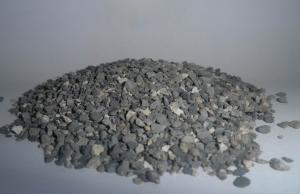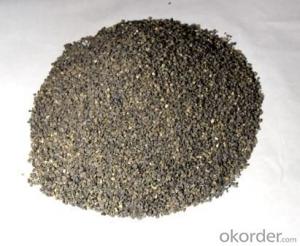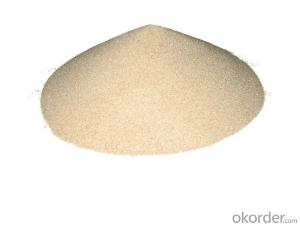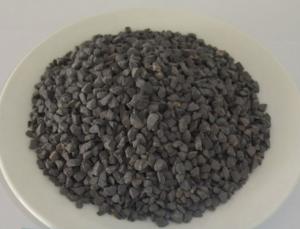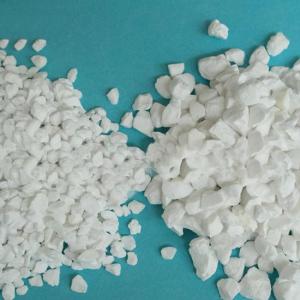Raw Materials for Refractory:High Performance Zircon Sand and Zircon Flour Powder
- Loading Port:
- Tianjin
- Payment Terms:
- TT OR LC
- Min Order Qty:
- 25 m.t.
- Supply Capability:
- 3000 m.t./month
OKorder Service Pledge
OKorder Financial Service
You Might Also Like
Refractory Material/ Zircon Sand and Zircon Flour Powder Good Performance
1.Structure of Zircon Sand and Zircon Powder
We are offer zircon sand With Below Mention Descriptions: ZrO2 65 - 67 %. We are offer zircon sand With Below Mention Descriptions: ZrO2 65 - 67 %. Zircon is a remarkable mineral, if only for its almost ubiquitous presence in the crust of Earth. It occurs in igneous rocks as primary crystallization products, in metamorphic rocks and in sedimentary rocks as detrital grains.
Further, the mineral due to hardness, durability and chemical inertness, zircon persists in sedimentary deposits and is a common constituent of most sands.
2.Main Features of Zircon Sand and Zircon Powder
1 Tiny, round, solid ball shape provides greater surface area for improved performance and dispersion in its application
2 High refractory rating, lower specific gravity rating, and higher service temperature produces greater yield
3 With lower bulk density, it offers better air permeability for better performance as a result of its overall physical characteristics
3.Main usage of Zircon Sand and Zircon Powder
Ceramic Industries – Wall Tiles , Floor Tiles , Roofing Tiles
Sanitary Ware Industries
Pottery Industries
Porcelain Glazes
Frit for Glaze and Enamels
Ceramic Colour Industries
Admixture for Glass , Opal Glass
Picture Tube Industries
Foundries , Investment Casting Industries
Special Refractories , Castable Refractories
Zircon Bricks , Zirconium Oxide Industries
Epoxy Resin , Special Paints Industries
4. Zircon Sand and Zircon Powder Images



5. Zircon Sand and Zircon Powder Specification
| Grade | Zr | Fe | Ti |
| A | 66min | 0.06max | 0.08max |
| B | 65.5min | 0.1max | 0.1max |
| C | 65min | 0.15max | 0.2ma |
6.FAQ of Zircon Sand and Zircon Powder
1). Q: Are you a factory or trading company?
A: We are a factory.
2). Q: Where is your factory located? How can I visit there?
A: Our factory is located in China. You are warmly welcomed to visit us!
3). Q: How can I get some samples?
A: Please contact me for samples
- Q: What is the best refractory company?
- Chinese brick trading network, is the most authoritative third party service platform, brought together more than 3000 refractory enterprises, working day experts online to answer, to analyze and evaluate the refractory industry, at the same time, cooperation with some refractories Association, I hope to help you!
- Q: How long is the fire-fighting time of A class fire resisting window?
- Duration of fire resistance of A class fire resisting window is not less than 1.2 hours; B class window is not less than 0.9 hours. And when install fire window, you must use Level to correct or use hanging line method to correct verticality of four directions, making its same horizontally anf vertically. Window frame must be integrated with the building, using wooden or metal parts connected to the wall. After steel frame is installed, cement mortar must be watered between window frame and wall , and is maintained more than 24 hours before normal use.
- Q: How to detect the acid resistance of refractory? Is there any standard? Thank you
- What material it is. There are many kinds of refractory materials, and I basically understand all petrochemical refractory.
- Q: What are the structural properties of refractory materials provided by the manufacturer of the refractories include?
- Metal oxides have very good resistance to high temperature, such as: three, two aluminum oxide, Magnesium Oxide...
- Q: Who knows about ranking rules of fireproofing thermal insulation materials for exterior wall?
- (1) the height of buildings is greater than or equal to 24 m, the combustion performance of thermal insulation material should be A-level. (2) the height of buildings is less than 24 m, the combustion performance of thermal insulation materials should be A- or B1-level. When using B1-level thermal insulation materials, fire barrier zone should be set in each floor. (3) incombustible materials should be used as the protective layer of thermal insulation materials. Thermal insulation materials should be completely covered by protective coatings. The thickness of protective layer should be no less than 3 mm. (4) The base walls should be set in buildings with nontransparent curtain wall structures of metal, stone,etc. The fire endurance of which should comply with relevant provisions of current fire?safety?rules on fire endurance of external wall. The fire endurance and fire protection construction of pier?between?two?windows, window sill walls, skirt walls of glass?curtain?walls should comply with relevant provisions of current fire?safety?rules on building curtain walls. (5) the internal cavity of base walls, as well as the space between the skirt wall and base walls, pier?between?two?windows, window sill walls should be sealed with fire-proof sealing materials at each floor.
- Q: What are the types of refractory sealant?
- According to the environmental temperature of the region, it is divided into stpl-1 type, stpl-2 type, stpl-3 type. The three models are respectively applied to sealing repair of regular and irregular crack in asphalt / cement concrete roads, highways, airport runways, which are of different temperatures. Stpl-1 type: It is suitable for pavement temperature (0℃to 80 ℃) stpl-2 type: It is suitable for pavement temperature (-15℃to 60 ℃) stpl-3 type: It is suitable for pavement temperature (-30 ℃ to 40 ℃)
- Q: how does the fire endurance of first rate fire resistant window?
- the classes are different. class A window not less than 1.5 hours, and the time is short, class B window not less than 1 hours, with shorter time, Class C window not less than 0.5 hours.
- Q: How is the development of Xinmi refractories industry? What's its advantages and disadvantages?
- I don't know how it has developed. Its advantage is the coal industry. You have to know the generating capacity in Xinmi thermal power plant first, and then you will know their coal cinder yield, after all, this is the raw material. Xinmi is not far away from Zhengzhou. The real estate in Zhengzhou is still good. I'm not sure about the others.
- Q: Do you know where I can buy refractories?
- A Address of Guangzhou Lingnan Refractories Co., Ltd. : No.1069 Guanghua 1st Road B Address of Guangzhou Aolian Refractories Co., Ltd. :
Send your message to us
Raw Materials for Refractory:High Performance Zircon Sand and Zircon Flour Powder
- Loading Port:
- Tianjin
- Payment Terms:
- TT OR LC
- Min Order Qty:
- 25 m.t.
- Supply Capability:
- 3000 m.t./month
OKorder Service Pledge
OKorder Financial Service
Similar products
Hot products
Hot Searches
Related keywords







